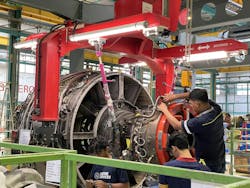Embracing Change: How Implementing New Maintenance Technology Can Help Mitigate Workforce Shortages
Key Highlights
- Implementing new technologies helps reduce the learning curve for young technicians, making it easier to scale operations and improve efficiency across dispersed teams.
- AI tools, including generative AI, enable technicians to quickly identify critical issues, prioritize tasks and access vital information, enhancing decision-making and aircraft readiness.
- Digitizing processes and capturing tribal knowledge prevent the loss of critical insights, supporting workforce development and operational continuity for future generations.
In light of the still persistent AMT shortage, maintenance providers started embracing new technologies in an attempt to appeal to new skilled technicians and enhance overall operations, seeing real results.
A recent webinar hosted by the National Business Aviation Association (NBAA), entitled “Predict, Prevent, Perform: The New Era of Maintenance Intelligence in Business Aviation,” highlighted how embracing new tech and tools has benefited maintenance organizations looking to attract and retain more young talent.
How does the technician shortage factor in?
Referencing Veryon’s 2025 Aviation Maintenance Benchmark Report, Senior Account Executive Kyle Sale shares, “The technician shortage is one of the loudest signals that we've seen inside the benchmark report. 62% of operators say the technician shortage is a critical threat to their operations.”
Sale added, “And when you combine that with a lot of very experienced folks moving on to other things, as we continue over 40 years in the industry, where are those young techs coming in? Those green horns that we need to train up and give the tools they need to succeed.”
Sale also conducted an audience poll during the presentation, which resulted in 45% of respondents stating that one of their major pain points is recruiting qualified technicians.
Why does embracing new technology help recruit and retain technicians?
When discussing the importance of implementing new technology and digital tools in MRO operations, Sale noted, “This isn't just for the leadership reading the dashboards and trying to comb the analytics. It’s all the way down to the maintenance technicians that are turning the wrenches, doing the QA signoffs and getting those aircraft RTS as fast as possible.”
Sale said, “Technology is helping operators reduce the learning curve for the rookies coming out of school…I think that's a reality when we start to think about how we're going to be able to scale these. We can only scale through using the tools that are available to us, and technology is a great way to scale, especially when those teams are spread thin.”
Sale was joined by Maintenance Record Consultant at Aero Review LLC Reaves Worrel, who has had firsthand success with adding new technologies into maintenance processes.
Turning to Worrel for insight on using tech to mitigate staffing issues, Sales asked, “When you're short on staff, what's one of the first tasks or processes that you might lean on to handle? Whether that's technology or a new process that you may have come up with that you were working on.”
Worrel answered, “I think the best answer to that is that if you have a system that saves your technicians time—i.e. makes them successful in their processes—then they're able to complete things quicker and more efficiently but still do them every bit as well.”
“That's where the technology comes in, it enables them to be more efficient at completing that whole process of logbook entries, paperwork, things that just suck time out of your normal day,” added Worrel.
How can AI tools be useful to new technicians at MROs?
Discussing the practical applications of digitizing MRO processes and using new technological tools, Sale highlighted some specific options.
He shared, “There's tools out there that are available right now that, with Gen AI, allow you to talk to your fleet, and then there's agentic AI agents that enable your fleet to talk to you.”
Sale continued, “Imagine if your youngest techs could walk in and pick up their tablet and simply ask, based on mission schedule: What are the most critical AOGs and items approaching tolerance I should focus on today? And it would instantly read out what must be returned to service first.”
Where to start digitizing MRO processes and trying new technology and tools
Reflecting on the same audience poll about pain points for maintenance providers and operators implementing new systems and digital tools, Sale shared, “Almost 30% of the audience said that user experience and training burden are some of the issues of getting people to use it, working with the software.”
Sale asked what was one thing Worrel wishes maintenance software providers get right. Worrel said, “The people training maintenance technicians really need to come from that background, because they speak that language, and they see it from that point of view. I think that would be super helpful in integrating these digital systems.”
Aside from ensuring skilled training staff to educate veteran and new technicians about technological developments, Sale asked Worrel for examples of methods that he’d seen to be successful at his organization.
Sale asked, ““How did you see your operators adapt? I think we've mentioned some of them, like automating processes, cross training. You mentioned having somebody kind of carry them through that, or we're seeing some of these intelligence tools that ease staff workloads. Can you give an example?”
Worrel answered, “I think really what happens is you eliminate those old paper layers of redundant work. If a parts person puts in the correct total time on a part, then the mechanic shouldn't have to research that, because the computer system carries that over.”
He continued, “And then if that's done correctly, it eliminates errors. If you eliminate errors, then your records people aren't so pushed. Everyone basically has more time to do the important things versus chasing all the things that they got missed in those older processes.”
“I think what’s going to have to happen in the industry is, through all these tools, you have to reduce the dependence on tribal knowledge,” said Worrel, touching on the generational gap in the AMT workforce, “So, what walks out the door with the gray-haired guy, if you’ve taken good notes and put that into your database, that information is available to any user moving forward.”
He concluded, “It’s a way to capture the insider tricks to a particular maintenance function or something. We use it all the time. We populated those notes with specific information that would help people from not making the mistakes that we made as we learned it. That’s how you’re going to help this next generation succeed.”



